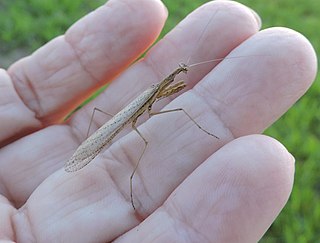
The International Union for Conservation of Nature (IUCN) Red List of Threatened Species, founded in 1964, is the world's most comprehensive inventory of the global conservation status of biological species. It uses a set of criteria to evaluate the extinction risk of thousands of species and subspecies. These criteria are relevant to all species and all regions of the world. With its strong scientific base, the IUCN Red List is recognized as the most authoritative guide to the status of biological diversity. A series of Regional Red Lists are produced by countries or organizations, which assess the risk of extinction to species within a political management unit.

Chinchillas are either of two species of crepuscular rodents of the parvorder Caviomorpha. They are slightly larger and more robust than ground squirrels, and are native to the Andes mountains in South America. They live in colonies called "herds" at high elevations of up to 4,270 m (14,000 ft). Historically, chinchillas lived in an area that included parts of Bolivia, Peru, Argentina, and Chile, but today, colonies in the wild are known only in Chile. Along with their relatives, viscachas, they make up the family Chinchillidae. They are also related to the chinchilla rat.

Sturgeon is the common name for the 27 species of fish belonging to the family Acipenseridae. The earliest sturgeon fossils date to the Late Cretaceous, and are descended from other, earlier acipenseriform fish who date back to the Triassic period some 245 to 208 million years ago. The family is grouped into four genera: Acipenser, Huso, Scaphirhynchus and Pseudoscaphirhynchus. Four species may now be extinct. Two closely related species, Polyodon spathula and Psephurus gladius are of the same order, Acipenseriformes, but are in the family Polyodontidae and are not considered to be "true" sturgeons. Both sturgeons and paddlefish have been referred to as "primitive fishes" because their morphological characteristics have remained relatively unchanged since the earliest fossil record. Sturgeons are native to subtropical, temperate and sub-Arctic rivers, lakes and coastlines of Eurasia and North America.

Skinks are lizards belonging to the family Scincidae, a family in the infraorder Scincomorpha. With more than 1,500 described species, the family Scincidae is one of the most diverse families of lizards.

Psilocybin mushrooms, commonly known as magic mushrooms or shrooms, are a polyphyletic, informal group of fungi that contain psilocybin which turns into psilocin. Biological genera containing psilocybin mushrooms include Copelandia, Gymnopilus, Inocybe, Panaeolus, Pholiotina, Pluteus, and Psilocybe. Psilocybin mushrooms have been and continue to be used in indigenous New World cultures in religious, divinatory, or spiritual contexts. They may be depicted in Stone Age rock art in Africa and Europe, but are most famously represented in the Pre-Columbian sculptures and glyphs seen throughout North, Central and South America.

Wildlife conservation refers to the practice of protecting wild species and their habitats in order to maintain healthy wildlife species or populations and to restore, protect or enhance natural ecosystems. Major threats to wildlife include habitat destruction/degradation/fragmentation, overexploitation, poaching, pollution and climate change. The IUCN estimates that 27,000 species of the ones assessed are at risk for extinction. Expanding to all existing species, a 2019 UN report on biodiversity put this estimate even higher at a million species. It's also being acknowledged that an increasing number of ecosystems on Earth containing endangered species are disappearing. To address these issues, there have been both national and international governmental efforts to preserve Earth's wildlife. Prominent conservation agreements include the 1973 Convention on International Trade in Endangered Species of Wild Fauna and Flora (CITES) and the 1992 Convention on Biological Diversity (CBD). There are also numerous nongovernmental organizations (NGO's) dedicated to conservation such as the Nature Conservancy, World Wildlife Fund, and Conservation International.

Ferrissia is a genus of small, air-breathing freshwater limpets, aquatic gastropod mollusks in the family Planorbidae, the ram's horn snails and their allies.

Condicinae is a subfamily of moths in the family Noctuidae. The subfamily was erected by Robert W. Poole in 1995.
Oligonicella scudderi, common name Scudder's mantis or slender prairie mantid, is a species of praying mantis native to the southern United States. It is a small brown insect; the males can fly but the females are wingless.
Thesprotia subhyalina, common name grass mantis, is a species of praying mantis found in Brazil. It was originally identified as Oligonyx subhyalina.
Oligonyx is a genus of moths of the family Noctuidae erected by Shigero Sugi in 1982; the name is a junior homonym of the mantis genus OligonyxSaussure, 1869, and must be replaced, following the International Code of Zoological Nomenclature. Despite that, its only species, Oligonyx vulnerata, was first described by Arthur Gardiner Butler in 1878. It is found in south-eastern Siberia, Korea, Japan, northern and central China.

Thespidae is a family of Neotropical insects in the order Mantodea. Following a major revision of this order in 2019, the old-world subfamilies Haaniinae and Hoplocoryphinae, previously placed here, have been upgraded to family level.
The Plant List is a list of botanical names of species of plants created by the Royal Botanic Gardens, Kew and the Missouri Botanical Garden and launched in 2010. It was intended to be a comprehensive record of all known names of plant species over time, and was produced in response to Target 1 of the 2002-2010 Global Strategy for Plant Conservation, to produce "An online flora of all known plants.” It has not been updated since 2013, and is superseded by World Flora Online.
Oligonyx is a genus of mantises in the family Thespidae.
Oligonyx bicornis is a species of mantid in the family Thespidae.
Oligonyx bidens is a species of mantid in the family Thespidae.
Oligonyx insularis is a species of mantid in the family Thespidae.
Oligonyx maya is a species of mantid in the family Thespidae.
Thespinae is a subfamily of mantids in the family Thespidae. There are 16 genera and at least 40 described species: found in Australasia, Central and South America.








